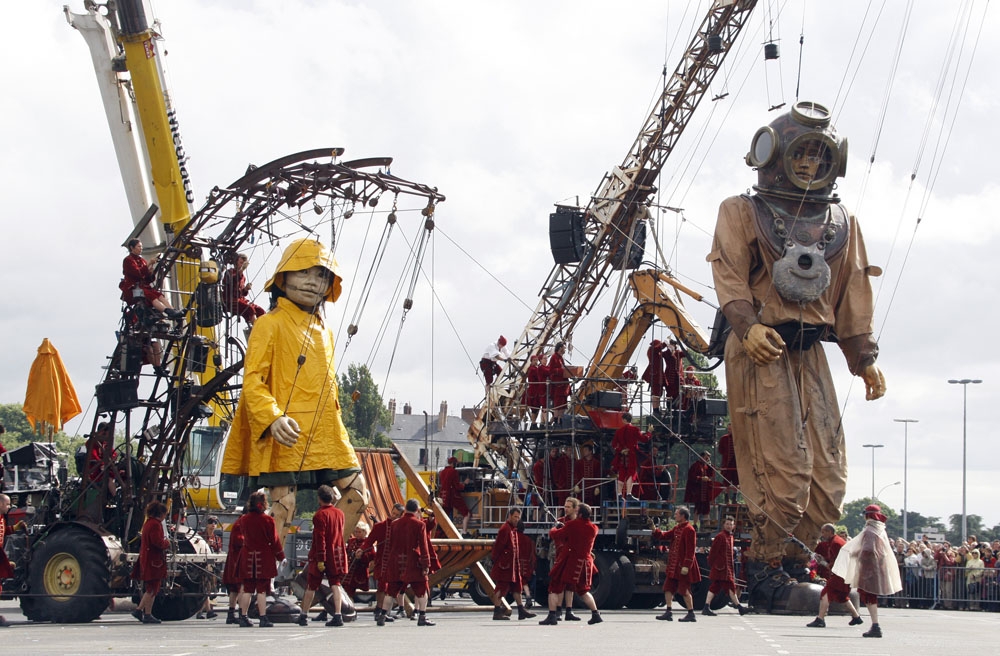


Today, the notion of “puppet theatre” seems to have lost its relevance. There are suggestions that is should be replaced with “theatre of animation”, “theatre of object”, “visual theatre”, “figurative theatre”, “theatre of inanimate matter”, etc. Here is the first reason: in the audience’s perception, puppets are steadily associated with childhood, with the things that invite tenderness and therefore should not be treated seriously. The second reason is that “in puppet theatre puppets should be on stage”. Yet there are no puppets there.
In Russian tradition there is a standard set of clichés, in most cases supported by the puppeteers themselves, who build their own professional borders and later try to cross them.
In one of the interviews, in reply to the journalist’s awkward utterance: “But you have lived a part of your life with puppets!” Rezo Gabriadze calmly objected: “I have not lived with puppets. I was doing exactly the same thing as in film – telling you stories. Those can be told with the help of sticks or dancing…”
“Do you imply that you have not formed any relationships with them?”
“I am often asked: what do puppets think about at night? My answer is: what do a clarinet, a grand piano, a writer’s quill think about at night? Or a stool? How would I know… I do not deal with such sweet sentiments. For me these are all just instruments.”[1]
With the coming of the era of directing, the puppet in theatre turned into an instrument for author’s expression. From a traditional, conventional kind of art, puppet theatre transformed into a space where modeling of any form, balancing of various scales and shapes, visualization of any metaphor became possible. If historically every technological system of puppets had been a miniature model of the world, in the 20th century the number of such models became endless – matching the number of authors who created them. Like modernists in painting, puppeteers are capable of creating their own artistic realities, unlimited as far as the choice of means, technologies, and materials are concerned. It is in this dimension of absolute freedom of theatre imagination that Philippe Genty and Rezo Gabriadze created their finest productions; today in this space we witness peaceful coexistence of the Lilikan productions of Moscow’s SHADOW Theatre Company (audience – 3–5 people) with the giant puppets of the French company Royal de Luxe, which consider the entire city their stage.
In this context, the widely used statement that the puppet is the center of puppet theatre looks quite weird. This deliberate self-isolation (dating back to the Soviet times) has resulted in the fact that puppet theatre is virtually excluded from the range of aspects discussed by the professional community and nowadays has to regain its positions. Puppet theatre has to prove the obvious truths: it is not the puppet, but the puppeteer that invents his or her own theatre. The production is an author’s statement. The puppet remains in the history as an artifact, but it is implied that it was created by someone’s hands. Today the tradition does not determine the choice of material, interdisciplinary and cross-species boundaries have become a formality, and puppet theatre exists in the universal cultural space of the 21st century. Understanding its position in this space, formulating its specifics, pushing the limits of perception – these are the objectives of our new magazine.
As theatre was born in ancient times, we decided to go back to the origins and named our magazine The Neurospaste. “Neurospaste” is the ancient Greek name for the actor-puppeteer (neurospaston [Latin] – marionette), literally meaning “the one who pulls the strings.” At the beginning of the 20th century, when puppet theatre found itself the center of attention of theatre avant-garde, the term “neurospaste” came into common professional use as actor-creator, author of one’s own artistic universe.
The magazine will be published once a year, the plan for the future is to make it fully bilingual. The Bolshoi Puppet Theatre already had the experience of creating a magazine: since 1959, during the time of M. M. Korolyov, self-published magazine Shirmotrostevsky (literally – “Of Screens and Rod Puppets”) had been coming out. Not only did it reflect on the inner life of the theatre and document the contemporary process, but it also became some kind of “a window to Europe” for puppeteers, because it published translations of overviews by colleagues from abroad.
The subject of the first issue is Contemporary Puppet Theatre. This subtitle of BTK-FEST, invented three years ago, became for us a universal definition of puppet theatre, which we like. The theatre which is traditional or radical, with or without puppets, the theatre of inanimate matter and “visual poetry” – the theatre, which is auteur, contemporary, and alive.
We would like to thank everyone who has responded and agreed to take part in this initiative.
[1] Gabriadze R. I Created Something Beautiful for You / Conversation with Yekaterina Varkan // Ogonyok. 2004. # 16. P. 18.